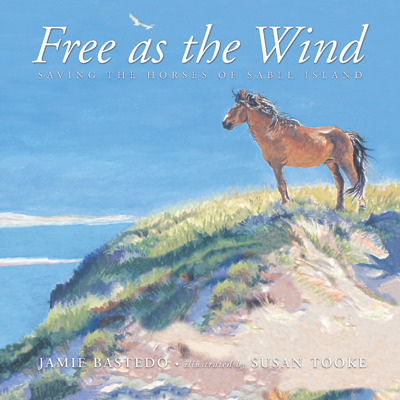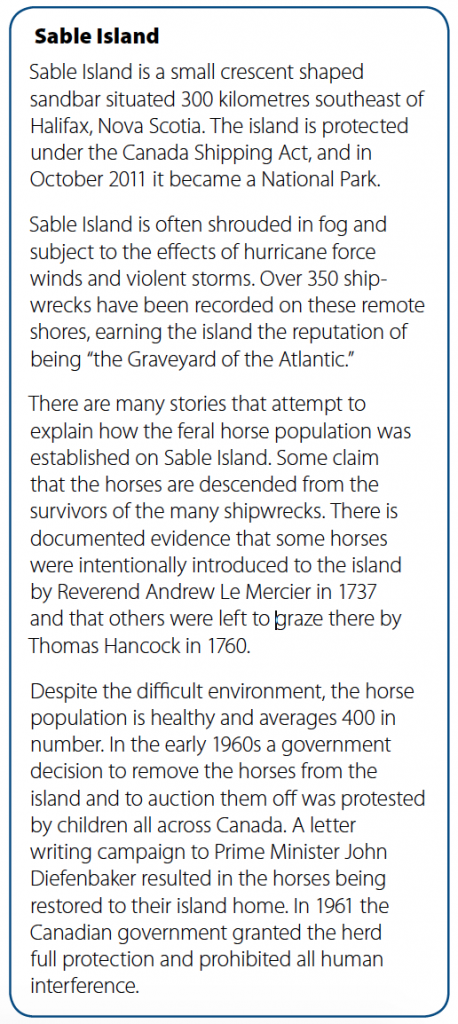A Transforming Lesson Plan
What is Historical Fiction?
Historical fiction is a distinct genre. It tells stories that are set in the past and are based on real events and people. As the stories are works of fiction, the main characters are usually invented and we often see the historical events and details through their eyes.
Why Use Historical Fiction in the Classroom?
Using historical fiction in the classroom (particularly picture books) is a colourful and engaging way to zoom in on the details of everyday life of a particular time period. Good historical fiction not only helps to build background knowledge about an era, it also provides students with accurate accounts that can easily be linked to the Social Studies curriculum.
 Free as the Wind
Free as the Wind
Saving the Horses of Sable Island
by Jamie Bastedo
Red Deer Press, 2010
ISBN 978-0-88995-446-5 (pb)
$11.95, 32 pp, ages 7 – 10
www.reddeerpress.com
This story takes place in the early 1960s when a government decision was made to eliminate the position of superintendent for Sable Island and to auction off the herds of wild horses in Halifax. As the story begins, the superintendent’s family reluctantly packs to leave. On the last day, Lucas, the superintendent’s son, says his goodbyes to his favourite horse, Gem, and watches as some of the horses are rounded up for shipping. The following day, on the steamer to Halifax, Lucas hears banging noises down in the hold.
 I sneak down the gangway. Eighteen horses are stuffed like sardines into little plywood stalls. Snorting. Kicking.
I sneak down the gangway. Eighteen horses are stuffed like sardines into little plywood stalls. Snorting. Kicking.
I see Gem and approach him slowly. He stops kicking and snorts at me. His eyes roll, his breath comes quickly.
“Don’t worry. I promise I’ll get you back home soon.”
Gem simmers down and whinnies, as if to say, “I believe you.”
I turn and walk slowly up the gangway into the sunlight.
Just don’t ask me how I’m going to do it.
A few weeks after the family had settled into their new home and school, the following headline appears in the paper: Ponies of Sable Island Destined for Dog Food.
Many people are upset by this news item, but for this young boy the article acts as a catalyst for action. Lucas and his classmates write letters to the Prime Minister of Canada asking him to intervene and return the horses to Sable Island. Soon, children from all across the country join the letter-writing campaign. Prime Minister John Diefenbaker responds to the campaign and the horses are taken back to their island home.
A few days later, Dad and I visit Sable Island to help free the horses. Gem is the last horse to unload from the surfboat. He’s probably the oldest one that went to Halifax. He would have been dog food for sure.
Blake struggles to untie Gem’s legs. “Give us a hand, will you Lucas?”
I’m glad to help this time. I steady Gem’s head and stroke his neck. “It’s okay now, boy.”
Gem stands up, quick as a colt, knocking Blake over. Blake jumps up laughing and claps his hands. “Good show, old boy!”
But Gem can’t hear him. He’s already running down the beach, clipping the sea foam with his hooves.
Lesson: Transforming Your Thinking
The following lesson is adapted from Adrienne Gear’s book, Reading Power. It works well with primary and intermediate classes. Readers are transformed by what they read when they make a shift in their own thinking. When talking to students about transforming (synthesis) it is important to emphasize that:
- Transforming means that they change the way they think about themselves and the world around them.
- Transforming may not take place right away. The ideas, facts, questions and inferences that surface while reading the story may be stored away in their memories for a long time.
Materials Required
1 copy of Free as the Wind
Before Reading
1. Explain to the class that you are going to read a book with an important message: everyone can make a difference.
2. Check to make sure that all students understand what you mean by transforming.
3. Let the students know that you will be asking them to talk about the book and explain any changes that they have made in their thinking or any new ideas that they might now have.
4. Explain that they will need to think about the story as it is being read to find out what parts matter most to them.
During Reading
1. Show the cover of the book to the class.
2. Ask the students to turn to predetermined partners to share what they think the story will be about.
3. Locate Sable Island on a map.
4. Read through the story. Take time to pause and look at the pictures, make predictions, discuss the story details, etc.
After Reading
1. Ask each student to turn to the same partner and discuss how Lucas managed to make a difference to the lives of the Sable Island horses.
2. Have some of the students share their ideas with the rest of the class.
3. Repeat this process with the following questions: Did this story change your thinking? Did it give you any new ideas? What could you do to make a difference to the world around you?
ABOUT THE AUTHOR
Brenda Boreham
Brenda has 35 years of classroom experience. She has presented workshops on literature-based themes and literacy strategies, and has written a number of resources for teachers. She remains passionate about matching up kids with books.
This article is from Canadian Teacher Magazine’s Nov/Dec 2012 issue.











